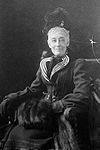Sag Harbor Whaling Museum facts for kids
The Sag Harbor Whaling and Historical Museum is a special place in Sag Harbor, New York. It teaches visitors all about the town's history with the whaling industry. This museum has the biggest collection of whaling equipment in New York. It helps us understand how people lived and worked long ago.
Contents
The Museum Building's Story
Building a Whaler's Home
The beautiful building that holds the museum was built in 1845. A rich merchant named Benjamin Huntting II had it built. He made his money from whaling, which was a very important business in Sag Harbor at that time.
A Unique Design
The house was designed by an architect named Minard Lafever. It is built in a style called Greek Revival. This means it looks a bit like an ancient Greek temple. It has tall, fancy columns at the front. What makes it really special are the decorations on the roof. They look like flensing knives and blubber spades, which were tools used in whaling. Also, two huge whale jawbones frame the front door! Inside, a grand staircase winds up to a domed skylight. Experts say it's one of the best examples of this type of architecture on Long Island.
From Home to Museum

In 1907, a kind lady named Margaret Olivia Slocum Sage bought the house. She was a philanthropist, which means she gave a lot of money to help others. She spent her summers there until she passed away in 1918.
After that, in 1920, the building became a Masonic Temple. The Freemasons are a fraternal organization. Then, in 1945, the Whaling Museum bought the building. The Freemasons still use the upper floor for their meetings today. The museum has been open to the public since 1945.
What You Can See at the Museum
Exploring Whaling History
The museum is full of interesting items from old whaling ships. You can see things like harpoons, guns, and large pots called try pots. These pots were used to melt whale blubber into oil. There are also flensing knives and blubber spades, which were used to cut up whales.
Art and Tools
You can also find beautiful figureheads, which are carved figures that used to be on the front of ships. The museum has a large collection of scrimshaw carvings. These are amazing artworks etched onto whale ivory or bone. In one room, called the Harpoon Room, you can see many different kinds of harpoons. There are also whale bones and tools used for shipbuilding. On the walls, you'll find paintings that show what whale hunts were like in the 1800s.


